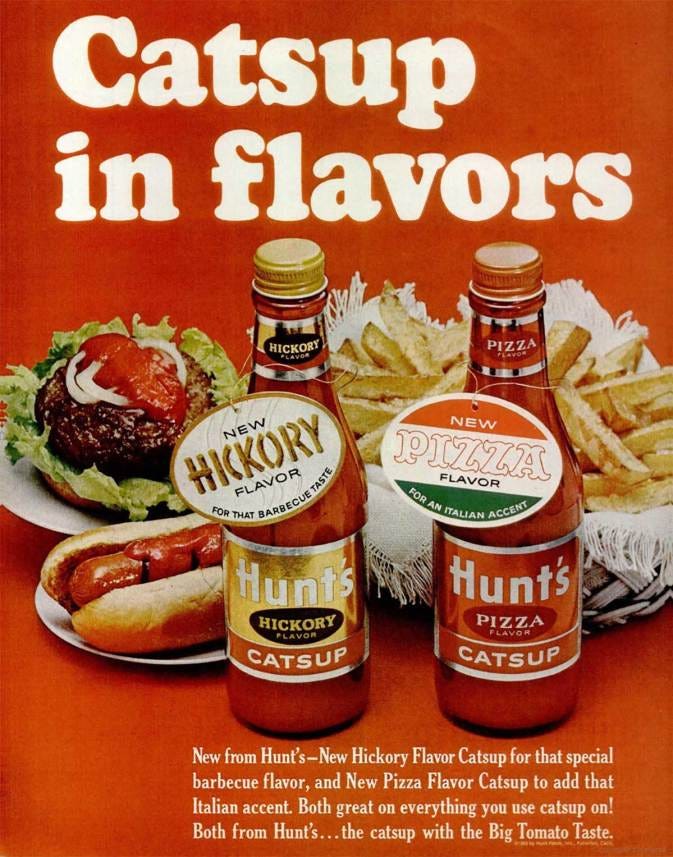Pizza Flavor Catsup
In 1965, the Hunts Company released three new catsup flavors that should have taken the world by storm. For some reason though, despite an apparent large advertising push, they did not change the way we look at catsup and they are hardly a footnote in condiment history.
The flavors they released were Hickory Flavor, for that Barbecue taste, Steakhouse Catsup, to add steakhouse class to any burger, and the very intriguing Pizza Flavor that promised to add an Italian accent to any food.
About Hunts
Hunts was founded in 1888 in Sebastopol, California, as the Hunt Bros. Fruit Packing Company by Joseph and William Hunt.
Ketchup vs. Catsup?
In the United States, Ketchup and Catsup are simply two different spellings for the same thing. Catsup used to be the dominant spelling, but ketchup now rules with only a few catsup holdouts.
Package Size and Price
Each bottle was 14 ounces and color-coded with delightful foil-style labels. Each of those bottles would run you about 20 cents in 1966. Adjusted for inflation that would be $1.62 in 2020.
The Ad Campaign
At the time of the release, Hunts hired the ad agency Hunt & Rubicon to create a commercial. It featured burgers waiting to get smothered by these new catsups with narration by character actor Herb Vigran. Conceived by Tom Sexton, Bill Frankey, and Richard R. Rucker, the ad was very well-received in creative circles, but sadly no copy is available to be viewed online.
What is online is a wonderful full-color print ad that appeared in various publications in 1965 and 1966. It features both the Pizza and Hickory Catsup along with foods most likely to be enhanced by the use of these wondrous condiments: hamburgers, french fries, and hot dogs.

Pizza Catsup Timeline
The earliest mention I can find of these flavored catsups from Hunts is a copyright filing from 1964. Mentions of its ads and supermarket circulars explode in 1965 and continue through 1966. People were paying attention to the ads because if you browse meatloaf recipes printed in newspapers starting in 1965, you will see lots of suggestions to try Pizza Catsup for a change of pace. These various mentions continue until 1969 and stop abruptly.
This doesn’t mean that the dream of a Pizza condiment had died though. In 1978 the Ragu brand released a Pizza Catsup adjacent product called, Ragu Table Sauce.
Enter Ragu Table Sauce
In 1978, the Chesebrough-Ponds company, which owned the Italian-style sauce brand Ragu, released a new product called “Ragu Table Sauce.” Billed as “Ketchup’s Italian Cousin,” Ragu Table Sauce claimed to have “an Italian personality all it’s own”
Released primarily in the Northeast section of the United States, the Table Sauce would march its was across the United States, eventually finding its way to the West Coast. I have seen evidence of it being sold in the South and Southwest, but not a lot.
In 1978, you could get a bottle for as low as 20 cents. By the time the last bottles of Table Sauce were hitting shelves in 1982/1983, the retail price had risen to 59 cents.
While not a huge hit, Ragu Table Sauce did have a lot more staying power than Pizza Catsup and is fondly remembered by people who bought it.
What did you put Table Sauce on? Well according to Ragu, just about everything.
Bring Pizza Catsup Back
It has been at least 50 years since Pizza Catsup and 40 years since Ragu Table Sauce has been on supermarket shelves. This seems like a big oversight. People are clamoring for novelty with their condiments and with salsa and various hot sauces continuing their rise, catsup needs to take some chances and try something new, or perhaps something old?
Everyone loves pizza. So imagine being able to make all of your favorite other foods taste more like pizza? It was a reality in the 1960s and it can be a reality again.





My grandparents would buy the Table Catsup, and we would put it on top of our homemade Chef Boyardee hamburger & onion pizza (after it was baked, cut in squares, and on our plates). As a child, I absolutely loved it, and really wish they would bring it back. Of course, it probably won’t taste the same with the high fructose corn syrup and other chemicals they now put in US foods.